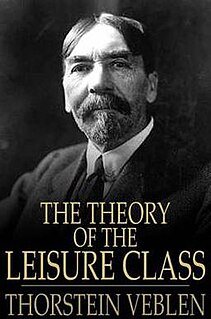Neoclassical economics is an approach to economics focusing on the determination of goods, outputs, and income distributions in markets through supply and demand. This determination is often mediated through a hypothesized maximization of utility by income-constrained individuals and of profits by firms facing production costs and employing available information and factors of production, in accordance with rational choice theory, a theory that has come under considerable question in recent years.
Evolutionary economics is part of mainstream economics as well as a heterodox school of economic thought that is inspired by evolutionary biology. Much like mainstream economics, it stresses complex interdependencies, competition, growth, structural change, and resource constraints but differs in the approaches which are used to analyze these phenomena.

Conspicuous consumption is the spending of money on and the acquiring of luxury goods and services to publicly display economic power—of the income or of the accumulated wealth of the buyer. To the conspicuous consumer, such a public display of discretionary economic power is a means of either attaining or maintaining a given social status.

Veblen goods are types of luxury goods for which the quantity demanded increases as the price increases, an apparent contradiction of the law of demand, resulting in an upward-sloping demand curve. Some goods become more desirable because of their high prices. For example, in the 1990s when "fashion" jeans became popular, one retailer was able to sell more after raising the price. A higher price may make a product desirable as a status symbol in the practices of conspicuous consumption and conspicuous leisure. A product may be a Veblen good because it is a positional good, something few others can own.
Backwardness is a lack of progress by a person or group to some perceived cultural norm of advancement, such as for example traditional societies relative to modern scientific and technologically advanced industrialized societies.
Institutional economics focuses on understanding the role of the evolutionary process and the role of institutions in shaping economic behaviour. Its original focus lay in Thorstein Veblen's instinct-oriented dichotomy between technology on the one side and the "ceremonial" sphere of society on the other. Its name and core elements trace back to a 1919 American Economic Review article by Walton H. Hamilton. Institutional economics emphasizes a broader study of institutions and views markets as a result of the complex interaction of these various institutions. The earlier tradition continues today as a leading heterodox approach to economics.
The word "value" is both a verb and a noun, each with multiple meanings. But its root meaning always involves social judgments of qualities such as goodness, worth, truth, justice, beauty. The word names either the rational criterion applied when judging, or results of judging, the presence of such qualities.

The technocracy movement is a social movement which arose in the early 20th century. Technocracy was popular in the United States and Canada for a brief period in the early 1930s, before it was overshadowed by other proposals for dealing with the crisis of the Great Depression. The technocracy movement proposed replacing politicians and businesspeople with scientists and engineers who had the technical expertise to manage the economy.
Technocracy is a proposed system of governance in which decision-makers are selected on the basis of their expertise in a given area of responsibility, particularly with regard to scientific or technical knowledge. This system explicitly contrasts with the notion that elected representatives should be the primary decision-makers in government, though it does not necessarily imply eliminating elected representatives. Leadership skills for decision-makers are selected on the basis of specialized knowledge and performance, rather than political affiliations or parliamentary skills.

Conspicuous leisure is a concept introduced by the American economist and sociologist Thorstein Veblen, in The Theory of the Leisure Class (1899). Conspicuous or visible leisure is engaged in for the sake of displaying and attaining social status. The concept comprises those forms of leisure that seem to be fully motivated by social factors, such as taking long vacations to exotic places and bringing souvenirs back. Conspicuous leisure is observed in all societies where stratification exists. Conspicuous leisure contributes to the glorification of non-productivity, thus validating the behavior of the most powerful classes and leading the lower classes to admire rather than revile the leisure class. This aids the leisure class in retaining their status and material position. Veblen's more well-known concept of "conspicuous consumption" is employed when non-productivity can be more effectively demonstrated through lavish spending.
Clarence Edwin Ayres was the principal thinker in the Texas school of Institutional Economics, during the middle of the 20th century.

The European Association for Evolutionary Political Economy (EAEPE) is a pluralist forum of social scientists that brings together institutional and evolutionary economists broadly defined. EAEPE members are scholars working on realistic approaches to economic theory and economic policy. With a membership of about 500, EAEPE is now the foremost European association for heterodox economists and the second-largest association for economists in Europe.
In the history of economic thought, a school of economic thought is a group of economic thinkers who share or shared a common perspective on the way economies work. While economists do not always fit into particular schools, particularly in modern times, classifying economists into schools of thought is common. Economic thought may be roughly divided into three phases: premodern, early modern and modern. Systematic economic theory has been developed mainly since the beginning of what is termed the modern era.
Institutionalist political economy, also known as institutional political economy or IPE, refers to a body of political economy thought stemming from the works of Thorstein Veblen, John Commons, Wesley Mitchell, John Dewey which emphasizes the impact of historical and socio-political factors on the evolution of economic practices.
Jonathan Nitzan is Professor of Political Economy at York University, Toronto, Canada.
There are several approaches to defining the substance and scope of technology policy.
Neo-classical economics has come under critique on the basis of its core ideologies, assumptions, and other matters.
Technological determinism is a reductionist theory that assumes that a society's technology determines the development of its social structure and cultural values. Technological determinism tries to understand how technology has had an impact on human action and thought. Changes in technology are the primary source for changes in society. The term is believed to have originated from Thorstein Veblen (1857–1929), an American sociologist and economist. The most radical technological determinist in the United States in the 20th century was most likely Clarence Ayres who was a follower of Thorstein Veblen and John Dewey. William Ogburn was also known for his radical technological determinism.







